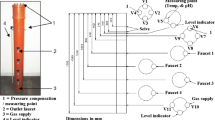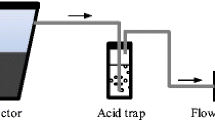Abstract
Ammonia emissions from poultry farms, including waste stockpiles, can degrade the environment and may be regulated in the USA. The main purpose of this study was to see how different poultry waste storage methods impacted ammonia loss. During a 13-day lab study, ammonia flux from uncovered (Control), covered with an inexpensive blue tarpaulin (Tarp), and stockpiles twice the depth of the Control stockpiles (Double-depth) were compared. Ammonia concentrations in the exhaust airstream from the stockpiles were measured using boric acid scrubbers. Ammonia loss per unit surface from the Tarp treatment was 45 % lower than the other treatments, while on a volume basis, losses from the Tarp and Double-depth treatment were 45 % vs. the Control stockpile. A less-pervious cover might have reduced ammonia losses even more. Ammonia flux per unit area from the Control and Double-depth treatments were comparable to those from large stockpiles in a shed monitored in a companion study though flux per unit volume was much higher from the lab stockpiles due to larger surface area per unit volume. Therefore, compared with a flatter stockpile, a more compact stockpile with a lower surface area per unit volume would have lower ammonia loss. Ammonia diffusion from the core of the stockpile to the surface may control ammonia flux, even in larger stockpiles in the short term (≤15 days), with nitrogen mineralization playing a smaller role. The 250-mL 3 % boric acid scrubbers were suitable for sampling air streams with ammonia concentrations up to 1,000 mg m−3 at 25 °C. At 25 °C, three moles of boric acid seemed adequate for each mole of ammonia to be trapped.


Similar content being viewed by others
References
Anthonisen, A. C., Loer, R. C., Prakasam, T. B. S., & Srinath, E. G. (1976). Inhibition of nitrification by NH3 and nitrous acid. Journal of Water Pollution Control Federation, 48, 835–852.
APHA. (1998). Standards methods for examination of water and wastewater (20th ed.). Washington, D.C.: American Public Health Association.
Dasgupta, P. K., & Dong, S. (1986). Solubility of ammonia in liquid water and generation of trace levels of standard gaseous ammonia. Atmospheric Environment, 20, 565–570.
EPA. (2011). Animal feeding operations air agreements. Washington, DC: EPA. Available at: http://www.epa.gov/compliance/resources/agreements/caa/cafo-agr.html. Accessed 21 August 2013.
EPA. (2012). NPDES permit writers' manual for concentrated animal feeding operations. EPA-833-F-12-001. Washington, DC: EPA. Available at: http://www.epa.gov/npdes/pubs/cafo_permitmanual_entire.pdf. Accessed 21 August 2013.
EPA. (2009). Rule change provides exemptions from reporting requirements for air releases of hazardous substances from farm animal waste. Washington, DC: EPA. Available at: http://www.epa.gov/region07/factsheets/2009/exemptions_air_farm_animal_waste0109.htm. Accessed 21 August 2013.
Jayaweera, G. R., & Mikkelsen, D. S. (1990). Ammonia volatilization from flooded soil systems: a computer model. I. Theoretical aspects. Soil Science Society of America Journal, 54, 1447–1455.
Kim, W. K., & Patterson, P. H. (2003). Effect of minerals on activity of microbial uricase to reduce NH3 volatilization in poultry manure. Poultry Science, 82, 223–231.
Liu, Z., Wang, L., Beasley, D. B., & Oviedo, E. (2007). Effect of moisture content on ammonia emissions from broiler litter: a laboratory study. Journal of Atmospheric Chemistry, 58, 41–53.
Misselbrook, T. H., Nicholson, F. A., Chambers, B. J., & Johnson, R. A. (2005). Measuring ammonia emissions from land applied manure: an intercomparison of commonly used samplers and techniques. Environmental Pollution, 135, 389–397.
Moore, P. A., Miles, D., Burns, R., Pote, D., Berg, K., & Choi, I. H. (2011). Ammonia emission factors from broiler litter in barns, in storage, and after land application. Journal of Environmental Quality, 40, 1395–1404.
NRC. (2003). Air emissions from animal feeding operations: Current knowledge, future needs. Washington: National Academy Press.
Nahm, K. H. (2003). Evaluation of the nitrogen content in poultry manure. World's Poultry Science Journal, 59, 77–88.
Ndegwa, P. M., Vaddella, V. K., Hristov, A. N., & Joo, H. S. (2009). Measuring concentrations of ammonia in ambient air or exhaust air stream using acid traps. Journal of Environmental Quality, 38, 647–653.
Perrin, D. D. (1969). Dissociation constants of inorganic acids and bases in aqueous solution. London: Butterworths Publishing.
Rio Tinto Minerals. (2007). Product data sheet: Ammonium pentaborate. Greenwood Village: Rio Tinto Minerals.
Rumpf, B., & Maurer, G. (1994). Solubility of ammonia in aqueous solutions of phosphoric acid: model development and application. Journal of Solution Chemistry, 23, 37–51.
Sagoo, E., Williams, J. R., Chambers, B. J., Boyles, L. O., Matthews, R., & Chadwick, D. R. (2007). Integrated management practices to minimize losses and maximize the crop nitrogen value of broiler litter. Biosystems Engineering, 97, 512–519.
SAS. (2008). SAS 9.1.3 service pack 4. Cary: SAS Institute, Inc.
Shah, S. B., Grabow, G. L., & Westerman, P. W. (2006). Ammonia adsorption in five types of flexible tubing materials. Applied Engineering in Agriculture, 22, 919–923.
Shah, S. B., Grimes, J. L., Oviedo-Rondón, E., & Westerman, P. W. (2013). Acidifier application rate impacts on emissions from US roaster chicken houses. Atmospheric Environment. Available at: doi:10.1016/j.atmosenv.2013.01.044. Accessed 21 August 2013.
Shah, S. B., Hutchison, K. J., Hesterberg, D. L., Grabow, G. L., Huffman, R. L., Hardy, D. H., et al. (2009). Leaching of nutrients and trace elements from stockpiled turkey litter. Journal of Environmental Quality, 38, 1053–1065.
Smith, R.-K. (1999). Handbook of environmental analysis (4th ed.). Schenectady: Genium Publishing Corp.
Sommer, S. G., McGinn, S. M., Hao, X., & Larney, F. J. (2004). Techniques for measuring gas emissions from a composing stockpile of cattle manure. Atmospheric Environment 38, 4643–4652.
Tasistro, A. S., Cabrera, M. L., Kissel, D. E., & Ritz, C. W. (2007). Study on the reduction of NH3 volatilization from broiler litter through the promotion of nitrification. Journal of Environmental Science and Health, Part A, 42, 549–556.
Tisdale, S. L., Nelson, W. L., Beaton, J. D., & Havlin, J. L. (1993). Soil fertility and fertilizers (5th ed.). New York: Macmillan Publishing Company.
Tukey, J.W. (1953). The problem of multiple comparisons. Unpublished manuscript. Princeton, NJ: Princeton University.
Wetselaar, R. (1985). Deep point-placed urea in flooded soil. In Proceedings of Workshop on Urea Deep Placement Technology, Special Pub. 6. Muscle Shoals: International Fertilizer Development Center.
Yao, H. (2009). Ammonia emission from stored broiler cake. MS thesis. Raleigh, North Carolina State University.
Yao, H., Shah, S. B., Willits, D. H., Westerman, P. W., Wang Li, L., & Marshall, T. K. (2011). Ammonia emissions from broiler cake stockpiled in a naturally ventilated shed. Transactions of ASABE, 54, 1893–1904.
Acknowledgments
This research was partly funded by the USDA-CSREES under the National Research Initiative Program (Award No. 2005‐05111) and the USDA Special Grants Program. H. Yao was partially supported by the Department of Biological and Agricultural Engineering (BAE), North Carolina State University, with an MS assistantship. BAE research associate C. Baird provided valuable support. The chemical analyses were performed at the BAE Environmental Analysis Lab. The authors are grateful to the broiler producer for providing the broiler cake.
Author information
Authors and Affiliations
Corresponding author
Rights and permissions
About this article
Cite this article
Shah, S.B., Yao, H. & Osborne, J.A. Storage Method Impacts on Ammonia Flux from Broiler Cake and Acid Scrubbers for High Ammonia Concentration Measurements. Water Air Soil Pollut 225, 1840 (2014). https://doi.org/10.1007/s11270-013-1840-6
Received:
Accepted:
Published:
DOI: https://doi.org/10.1007/s11270-013-1840-6




